|
Markets were in full vigil mode as the week began with investors awaiting the Federal Reserve’s policy decision on Wednesday afternoon. And there were no surprises although the statement was open to interpretation. The FOMC lowered the fed funds target rate the expected 25 basis points to 2 percent. The Fed did not state specifically that it was planning to pause, rather that had to be inferred from statement details. After the announcement, analysts parsed and reparsed it for definitive clues for the next policy move. Most analysts agreed that the Fed would pause in its series of rate cuts — but then again, nothing was specifically stated. With most analysts assuming that the Fed said they would pause, the dollar shot up against other major currencies, but especially against the euro. The Bank of Japan also met and kept their policy rate unchanged at 0.5 percent. Now the gap between U.S. and Japanese interest rates is 1.5 percent. These are the lowest rates among the Group of Seven countries.
With Thursday a holiday almost everywhere (except Japan, Australia, UK, Canada and the U.S.), investors focused on better than anticipated U.S. data. Most indicators released Thursday and Friday turned in better than expected results including first quarter advance gross domestic product and employment while personal income and expenditures met or exceeded estimates. The results infused investors with a burst of optimism that the U.S. economy was weathering the economic storm better than expected. And the mood was helped by Friday’s announcement of further coordinated action by the Federal Reserve, European Central Bank and the Swiss National Bank to ease money market stress.
The U.S. dollar benefited from weak European data and lower commodity prices as the dollar touched a five-week high against the euro and a two-month peak against the yen on speculation that the next move for U.S. rates might be upwards. Expectations that U.S. interest rates could be at — or at least close to — a bottom offered firm support to the dollar. The euro, by contrast, has been plagued by speculation that a deteriorating economic outlook would pressure the European Central Bank into lowering borrowing costs. It should be noted that ECB rhetoric does not back up this view.
For the record, most indexes were able to put a sizable dent in losses incurred during the first three months of the year. Only the Jakarta Composite and Taiex in Asia and the Bolsa in North America were down for the month. The same three indexes declined last week.
|
|
2007 |
2008 |
% Change |
|
Index |
Dec 31 |
Apr 25 |
May 2 |
Week |
Apr |
Year |
| Asia |
|
|
|
|
|
|
|
| Australia |
All Ordinaries |
6421.0 |
5658.7 |
5760.4 |
1.8% |
4.6% |
-10.3% |
| Japan |
Nikkei 225 |
15307.8 |
13863.5 |
14049.3 |
1.3% |
10.6% |
-8.2% |
|
Topix |
1475.7 |
1339.9 |
1377.4 |
2.8% |
12.0% |
-6.7% |
| Hong Kong |
Hang Seng |
27812.7 |
25516.8 |
26241.0 |
2.8% |
12.7% |
-5.7% |
| S. Korea |
Kospi |
1897.1 |
1824.7 |
1848.3 |
1.3% |
7.1% |
-2.6% |
| Singapore |
STI |
3482.3 |
3189.2 |
3236.1 |
1.5% |
4.7% |
-7.1% |
| China |
Shanghai Composite |
5261.6 |
3557.8 |
3693.1 |
3.8% |
6.3% |
-29.8% |
|
|
|
|
|
|
|
|
| India |
Sensex 30 |
20287.0 |
17126.0 |
17600.1 |
2.8% |
10.5% |
-13.2% |
| Indonesia |
Jakarta Composite |
2745.8 |
2240.6 |
2342.8 |
4.6% |
-5.8% |
-14.7% |
| Malaysia |
KLSE Composite |
1445.0 |
1288.1 |
1271.5 |
-1.3% |
2.6% |
-12.0% |
| Philippines |
PSEi |
3621.6 |
2777.9 |
2723.0 |
-2.0% |
-7.9% |
-24.8% |
| Taiwan |
Taiex |
8506.3 |
8947.8 |
8963.6 |
0.2% |
4.1% |
5.4% |
| Thailand |
SET |
858.1 |
832.2 |
843.2 |
1.3% |
1.9% |
-1.7% |
|
|
|
|
|
|
|
|
| Europe |
|
|
|
|
|
|
|
| UK |
FTSE 100 |
6456.9 |
6091.40 |
6215.50 |
2.0% |
6.8% |
-3.7% |
| France |
CAC |
5614.1 |
4978.21 |
5069.71 |
1.8% |
6.1% |
-9.7% |
| Germany |
XETRA DAX |
8067.3 |
6896.58 |
7043.23 |
2.1% |
6.3% |
-12.7% |
|
|
|
|
|
|
|
|
| North America |
|
|
|
|
|
|
|
| United States |
Dow |
13264.8 |
12891.9 |
13058.2 |
1.3% |
4.5% |
-1.6% |
|
NASDAQ |
2652.3 |
2422.9 |
2477.0 |
2.2% |
5.9% |
-6.6% |
|
S&P 500 |
1468.4 |
1397.8 |
1413.9 |
1.1% |
4.8% |
-3.7% |
| Canada |
S&P/TSX Comp. |
13833.1 |
14103.9 |
14280.3 |
1.3% |
4.4% |
3.2% |
| Mexico |
Bolsa |
29536.8 |
31009.0 |
30551.5 |
-1.5% |
-2.0% |
3.4% |
| Markets in Japan were closed on Tues, April 29 |
| Markets were closed in the following Asian countries on Thurs, May 1 -- Hong Kong, |
| South Korea, Singapore, India, Indonesia, Malaysia, Philippines, Taiwan and Thailand |
| Markets were closed in the following European countries on Thurs, May 1 -- Germany and France |
| Markets were closed in Mexico on Thursday, May 1 |
| Markets in China were closed on Thurs and Fri, May 1 and May 2 |
The CAC, DAX and FTSE were up for the third week, in part propelled by Friday’s better than expected U.S. employment situation report and on the coattails of early U.S. equity performance. With the exception of Friday, the FTSE barely moved in the first four days of trading, losing only 4 points. However, the index had already recovered its bounce prior to Friday’s U.S. data, and it took off. Both the CAC and DAX were closed Thursday while the FTSE was unchanged on the day. The 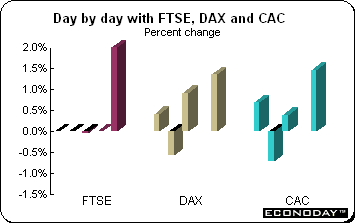 index was last unchanged on the day on June 8, 2007. It was the 14th time since 1984 that the index closed unchanged. index was last unchanged on the day on June 8, 2007. It was the 14th time since 1984 that the index closed unchanged.
European equity markets also jumped Friday with banking stocks benefiting from a rising U.S. dollar. All three indexes were up on signs of a tentative recovery for the U.S. economy. In addition to the employment report and rising factory orders which were released later in the U.S. morning, equities were also helped by news that the Federal Reserve was to pump an additional $50 billion into the financial system via its new money auctions. The Fed said it was acting in coordination with the European Central Bank and the Swiss National Bank.
In April, the three indexes gained over 6 percent each. The FTSE led with a gain of 6.8 percent and was trailed closely by the DAX, up 6.3 percent and the CAC, which gained 6.2 percent. On the year, the indexes are down 5.7 percent, 13.9 percent and 11.0 percent respectively. Equities gained in April due in part to better than expected earnings and the Federal Reserve’s moves to bolster investor confidence.
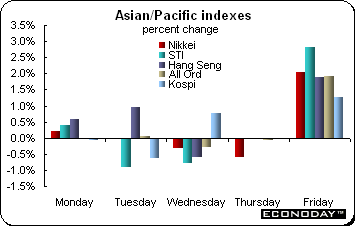 Most Asian/Pacific stock indexes were up last week. The exceptions were the Malaysian KLSE Composite and the Philippines PSEi, down 1.3 percent and 2 percent respectively. It was a relatively with little movement in a week that was strewn with holidays. And with most markets closed on Thursday, stocks caught up on Friday. Asian markets rallied on Wall Street's optimism, triggered by expectations that the U.S. economy will take a turn for the better. The major averages across the Asia/Pacific region closed Friday's session significantly higher, while the Chinese market remained closed for a second day. Most Asian/Pacific stock indexes were up last week. The exceptions were the Malaysian KLSE Composite and the Philippines PSEi, down 1.3 percent and 2 percent respectively. It was a relatively with little movement in a week that was strewn with holidays. And with most markets closed on Thursday, stocks caught up on Friday. Asian markets rallied on Wall Street's optimism, triggered by expectations that the U.S. economy will take a turn for the better. The major averages across the Asia/Pacific region closed Friday's session significantly higher, while the Chinese market remained closed for a second day.
Most reaction to the FOMC interest rate cut was muted because of the market closures for May Day. However, analysts were uncertain about the interest rate outlook. Investors seem to think that the Fed is now in a neutral mode and was adopting a wait and see attitude in order to see the lagging effects of its past monetary policy actions.
For the record in April, most of the indexes followed here made a significant dent in the losses incurred during the first quarter. The four best performers with gains over 10 percent on the month were the Hang Seng, Topix, Nikkei and Sensex with increases of 12.7 percent, 12.0 percent, 10.6 percent and 10.5 percent respectively. However, all the indexes followed here are down so far this year with the exception of the Taiwan Taiex.
Bank of Japan lowers growth expectations
As universally expected, the Bank of Japan left its key interest rate at 0.5 percent as growth weakens and inflation appears to be rising. Unlike recent meetings elsewhere, the vote was unanimous. March inflation data showed that both the CPI and CPI core that excludes only fresh food were both up 1.2 percent on the year for the fastest pace in 10 years. However, the core that excludes both fresh food and energy barely managed to edge up 0.1 percent on the year. With its bank rate at only 0.5 percent, the BoJ has little room to maneuver. The BoJ raised the key rate to 0.5 percent in February 2007.
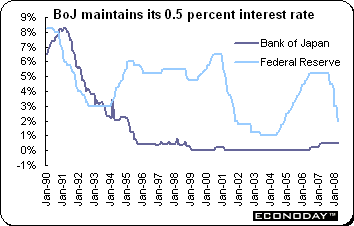 After the meeting’s conclusion the Bank of Japan released its semiannual Outlook. The Outlook for Economic Activity and Prices sets the parameters for policy over the next six to twelve months. As expected, the BoJ cut its economic growth forecast and predicted inflation would accelerate. However the report omitted a reference to raising interest rates for the first time in two years. The Bank estimated that the economy would grow 1.5 percent in the fiscal year ending March 31, less than an October estimate of 2.1 percent. The report said that the outlook for economic activity and prices is uncertain and, therefore, it is not appropriate to predetermine the direction of future monetary policy. Bank governor Masaaki Shirakawa said “that until the last report, our policy was aimed at adjusting interest-rate levels. This time, given that the economy is underperforming compared with expectations and risks are rising, our stance can be described as flexible. This is the best word to explain our policy stance.” After the meeting’s conclusion the Bank of Japan released its semiannual Outlook. The Outlook for Economic Activity and Prices sets the parameters for policy over the next six to twelve months. As expected, the BoJ cut its economic growth forecast and predicted inflation would accelerate. However the report omitted a reference to raising interest rates for the first time in two years. The Bank estimated that the economy would grow 1.5 percent in the fiscal year ending March 31, less than an October estimate of 2.1 percent. The report said that the outlook for economic activity and prices is uncertain and, therefore, it is not appropriate to predetermine the direction of future monetary policy. Bank governor Masaaki Shirakawa said “that until the last report, our policy was aimed at adjusting interest-rate levels. This time, given that the economy is underperforming compared with expectations and risks are rising, our stance can be described as flexible. This is the best word to explain our policy stance.”
The Bank also raised its forecast for consumer prices. They said that core consumer prices, which exclude fresh food, would rise 1.1 percent on the year compared with an earlier estimate of 0.4 percent. The Bank said it has kept rates unchanged since raising them in February 2007 because risks including higher energy costs and a domestic housing slump have created uncertainty in the economy. The bank removed language it had used since April 2006 that said it will adjust the level of interest rates gradually in accordance with improvements in the economic and price situation.
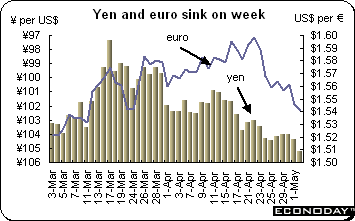 The U.S. dollar improved last week as a confluence of events conspired to give the currency a boost. Only two weeks after reaching an all time low against the euro, the currency has recovered sharply, triggering speculation that its long decline might be coming to an end. This week’s signal from the Fed that it would be pausing in its interest rate cutting cycle was the primary driving force behind the dollar’s rebound. However, improving equity markets and economic data also played a role. The dollar has declined along with interest rates since last summer as the Fed cut its policy interest rate by 3.25 percentage points to 2 percent. As the impact of the subprime mess spread, other major economies also felt the strain with the Banks of England and Canada cutting their policy rates as well — but not as drastically as the Fed. On the week, the dollar gained on all major currencies. The U.S. dollar improved last week as a confluence of events conspired to give the currency a boost. Only two weeks after reaching an all time low against the euro, the currency has recovered sharply, triggering speculation that its long decline might be coming to an end. This week’s signal from the Fed that it would be pausing in its interest rate cutting cycle was the primary driving force behind the dollar’s rebound. However, improving equity markets and economic data also played a role. The dollar has declined along with interest rates since last summer as the Fed cut its policy interest rate by 3.25 percentage points to 2 percent. As the impact of the subprime mess spread, other major economies also felt the strain with the Banks of England and Canada cutting their policy rates as well — but not as drastically as the Fed. On the week, the dollar gained on all major currencies.
|
|
2007 |
2008 |
% change |
|
|
Dec 31 |
Apr 25 |
May 2 |
Week |
Year |
| U.S. $ per currency |
|
|
|
|
|
|
| Australia |
A$ |
0.8776 |
0.9317 |
0.9361 |
0.5% |
6.7% |
| New Zealand |
NZ$ |
0.7740 |
0.7808 |
0.7815 |
0.1% |
1.0% |
| Canada |
C$ |
1.0120 |
0.9841 |
0.9813 |
-0.3% |
-3.0% |
| Eurozone |
euro (€) |
1.4603 |
1.5591 |
1.5412 |
-1.1% |
5.5% |
| UK |
pound sterling (£) |
1.9843 |
1.9831 |
1.9732 |
-0.5% |
-0.6% |
|
|
|
|
|
|
|
| Currency per U.S. $ |
|
|
|
|
|
|
| China |
yuan |
7.2946 |
7.01 |
6.9875 |
0.3% |
4.4% |
| Hong Kong |
HK$* |
7.7984 |
7.7902 |
7.7938 |
0.0% |
0.1% |
| India |
rupee |
39.4100 |
40.125 |
40.675 |
-1.4% |
-3.1% |
| Japan |
yen |
111.7100 |
104.468 |
105.43 |
-0.9% |
6.0% |
| Malaysia |
ringgit |
3.3057 |
3.1542 |
3.1628 |
-0.3% |
4.5% |
| Singapore |
Singapore $ |
1.4360 |
1.3627 |
1.3638 |
-0.1% |
5.3% |
| South Korea |
won |
935.8000 |
995.275 |
1010.5 |
-1.5% |
-7.4% |
| Taiwan |
Taiwan $ |
32.4300 |
30.34 |
30.5 |
-0.5% |
6.3% |
| Thailand |
baht |
29.5000 |
31.705 |
31.715 |
0.0% |
-7.0% |
| Switzerland |
Swiss franc |
1.1334 |
1.0366 |
1.0565 |
-1.9% |
7.3% |
|
|
|
|
|
|
|
| *Pegged to U.S. dollar |
|
|
|
|
|
|
| Source: Bloomberg |
|
|
|
|
|
|
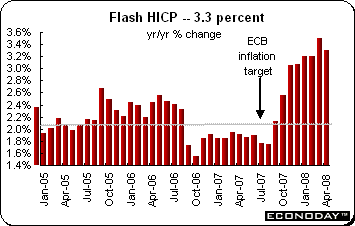 April flash harmonized index of consumer prices eased to an increase of 3.3 percent when compared with last year from 3.5 percent in March. While still uncomfortably above the ECB’s 2 percent inflation target, the dip is the first significant drop since September 2006 and the first of any size since August last year. As with all flash estimates, no initial details were provided. April flash harmonized index of consumer prices eased to an increase of 3.3 percent when compared with last year from 3.5 percent in March. While still uncomfortably above the ECB’s 2 percent inflation target, the dip is the first significant drop since September 2006 and the first of any size since August last year. As with all flash estimates, no initial details were provided.
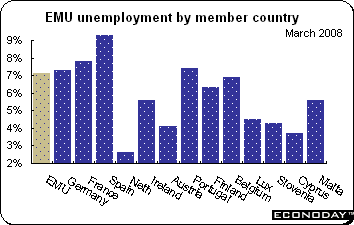 March unemployment remained at 7.1 percent for the third month. Among the larger EMU states reporting, the only country to see a decline was Germany (7.3 percent from 7.4 percent). The unemployment rate held steady in France (7.8 percent) while Spain saw yet another increase (9.3 percent from 9.1 percent). These unemployment rates compare with 3.8 percent in Japan and 5.1 percent in the U.S. March unemployment remained at 7.1 percent for the third month. Among the larger EMU states reporting, the only country to see a decline was Germany (7.3 percent from 7.4 percent). The unemployment rate held steady in France (7.8 percent) while Spain saw yet another increase (9.3 percent from 9.1 percent). These unemployment rates compare with 3.8 percent in Japan and 5.1 percent in the U.S.
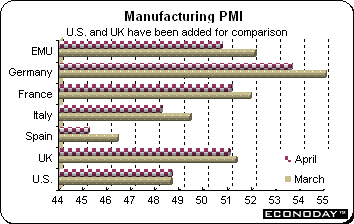 April purchasing managers manufacturing index weakened to 50.7, down from March’s reading of 52.1. The index remains above the 50 breakeven point overall but not for many of the major countries. The indexes were also down on the month for the major EMU countries. The PMI for Spain dropped to 45.2 from 46.4 while Italy was down to 48.2 from 49.4, France declined to 51.1 from 51.9 and Germany edged down to 53.6 from 55.1. Only France and Germany along with the UK continue to show signs of growth — albeit at a slower pace. The index is prepared by NTC Economics. April purchasing managers manufacturing index weakened to 50.7, down from March’s reading of 52.1. The index remains above the 50 breakeven point overall but not for many of the major countries. The indexes were also down on the month for the major EMU countries. The PMI for Spain dropped to 45.2 from 46.4 while Italy was down to 48.2 from 49.4, France declined to 51.1 from 51.9 and Germany edged down to 53.6 from 55.1. Only France and Germany along with the UK continue to show signs of growth — albeit at a slower pace. The index is prepared by NTC Economics.
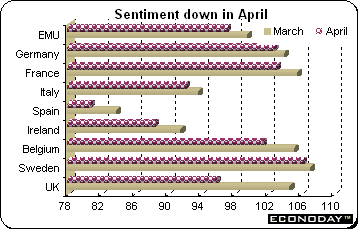 April economic sentiment declined to 97.1 from 99.6 in March. Consumer sentiment remained at minus 12 for the second month, while all other components declined. Particularly weak was the retail sector (minus 5 from 1) which saw an especially marked drop in confidence, but there were also sizeable dips in industry (minus 2 from 0) and services (7 from 9). Confidence in the financial services area is now at a record low. Construction was similarly well down (minus 12 from minus 9). Among the larger countries the decline in sentiment was once again most pronounced in Spain (80.7 from 83.9) while in France sentiment also fared poorly (103.1 from 105.6). Declines in Italy (92.1 from 93.7) and Germany (102.8 from 104.0) were somewhat less marked. April economic sentiment declined to 97.1 from 99.6 in March. Consumer sentiment remained at minus 12 for the second month, while all other components declined. Particularly weak was the retail sector (minus 5 from 1) which saw an especially marked drop in confidence, but there were also sizeable dips in industry (minus 2 from 0) and services (7 from 9). Confidence in the financial services area is now at a record low. Construction was similarly well down (minus 12 from minus 9). Among the larger countries the decline in sentiment was once again most pronounced in Spain (80.7 from 83.9) while in France sentiment also fared poorly (103.1 from 105.6). Declines in Italy (92.1 from 93.7) and Germany (102.8 from 104.0) were somewhat less marked.
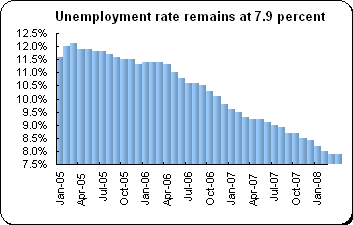 April unemployment was down 7,000 leaving the unemployment rate at 7.9 percent for the second month. Declines of only 5,000 in the West and an even smaller 2,000 in the East left total seasonally adjusted unemployment at 3,299,000 this month. Although unemployment was down last month, the drop was insignificant when compared with the average decline of 42,700 posted over the first quarter of 2008. Employment continued to gain in March (the most recently available data) but the 55,000 advance was the smallest since July last year (48,000). April unemployment was down 7,000 leaving the unemployment rate at 7.9 percent for the second month. Declines of only 5,000 in the West and an even smaller 2,000 in the East left total seasonally adjusted unemployment at 3,299,000 this month. Although unemployment was down last month, the drop was insignificant when compared with the average decline of 42,700 posted over the first quarter of 2008. Employment continued to gain in March (the most recently available data) but the 55,000 advance was the smallest since July last year (48,000).
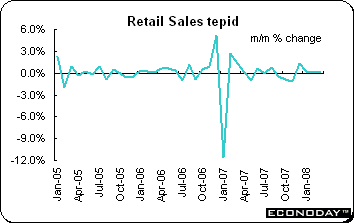 March retail sales excluding autos and gasoline stations dipped 0.1 percent to leave an annual decline of 1.2 percent. This was the second month in a row that consumer purchases have contracted and the sixth monthly decline since September. However, thanks to a sharply stronger revised 1.9 percent jump in January, retail sales for the quarter as a whole still show growth of 1.2 percent versus the previous period. Total sales including autos and gasoline stations were up 0.2 percent but down 0.1 percent on the year. March retail sales excluding autos and gasoline stations dipped 0.1 percent to leave an annual decline of 1.2 percent. This was the second month in a row that consumer purchases have contracted and the sixth monthly decline since September. However, thanks to a sharply stronger revised 1.9 percent jump in January, retail sales for the quarter as a whole still show growth of 1.2 percent versus the previous period. Total sales including autos and gasoline stations were up 0.2 percent but down 0.1 percent on the year.
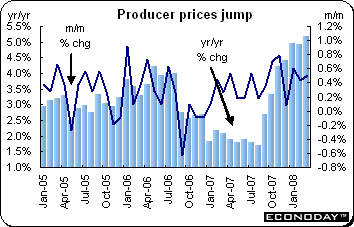 March producer price index was up 0.5 percent and 5.2 percent when compared with last year. The latest monthly gain reflected increases in most of the main product categories with only capital goods (down 0.1 percent) posting a decline. Leading the way were energy (1.6 percent) and agriculture & food (0.4 percent). Excluding these sectors, prices were up a modest 0.2 percent or just 1.8 percent from a year ago. Prices were up 0.4 percent in the intermediate goods sector for annual growth of 3.1 percent but edged up only 0.1 percent in the auto industry (0.6 percent on the year). In the consumer area prices were unchanged on the month (up 0.4 percent on the year). March producer price index was up 0.5 percent and 5.2 percent when compared with last year. The latest monthly gain reflected increases in most of the main product categories with only capital goods (down 0.1 percent) posting a decline. Leading the way were energy (1.6 percent) and agriculture & food (0.4 percent). Excluding these sectors, prices were up a modest 0.2 percent or just 1.8 percent from a year ago. Prices were up 0.4 percent in the intermediate goods sector for annual growth of 3.1 percent but edged up only 0.1 percent in the auto industry (0.6 percent on the year). In the consumer area prices were unchanged on the month (up 0.4 percent on the year).
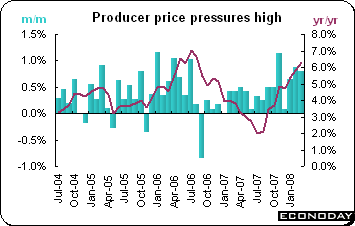 March producer prices soared 0.8 percent and 6.3 percent when compared with the same month a year ago. The latest monthly surge reflected in large part another leap in energy costs (2.3 percent) which masked much more moderate advances elsewhere. Consumer goods (0.4 percent), intermediate goods (0.4 percent) and capital goods (0.2 percent) all recorded moderate increases. Excluding energy, the PPI was up 0.4 percent on the month and 3.6 percent on the year. Among the various product categories, there were notably strong showings by coke & petroleum products (4.9 percent), minerals (1.2 percent) and metals (1.2 percent). However, declines in chemicals & synthetic fibres together with rubber & plastics and non-metallic minerals (all 0.2 percent) helped to restrict the monthly rise in total manufactured goods to 0.8 percent. March producer prices soared 0.8 percent and 6.3 percent when compared with the same month a year ago. The latest monthly surge reflected in large part another leap in energy costs (2.3 percent) which masked much more moderate advances elsewhere. Consumer goods (0.4 percent), intermediate goods (0.4 percent) and capital goods (0.2 percent) all recorded moderate increases. Excluding energy, the PPI was up 0.4 percent on the month and 3.6 percent on the year. Among the various product categories, there were notably strong showings by coke & petroleum products (4.9 percent), minerals (1.2 percent) and metals (1.2 percent). However, declines in chemicals & synthetic fibres together with rubber & plastics and non-metallic minerals (all 0.2 percent) helped to restrict the monthly rise in total manufactured goods to 0.8 percent.
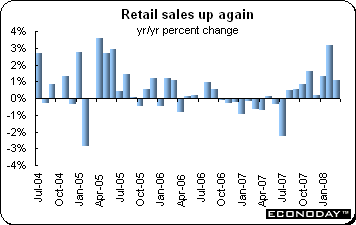 March retail sales were up 1.1 percent when compared with the same month a year ago. However, sales grew at a slower rate than February’s 3.2 percent gain on the year. Large scale retail store sales were up 0.2 percent on the year after adjustment for the change in the number of stores. Sales at department stores and supermarkets account for around 15 percent of total retail sales. This marked the second straight month of gains for adjusted large-scale retailers' sales. March retail sales were up 1.1 percent when compared with the same month a year ago. However, sales grew at a slower rate than February’s 3.2 percent gain on the year. Large scale retail store sales were up 0.2 percent on the year after adjustment for the change in the number of stores. Sales at department stores and supermarkets account for around 15 percent of total retail sales. This marked the second straight month of gains for adjusted large-scale retailers' sales.
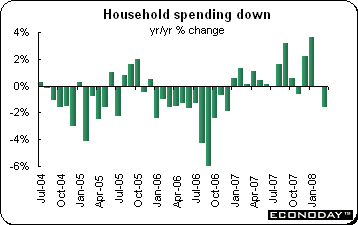 March household spending surprised analysts and sank 1.6 percent when compared with last year. Expectations were for an increase of 1.7 percent. This is in contradiction with the retail sales report released earlier in the week which showed a gain of 1.1 percent on the year. However worker household spending was down only 0.2 percent on the year. March household spending surprised analysts and sank 1.6 percent when compared with last year. Expectations were for an increase of 1.7 percent. This is in contradiction with the retail sales report released earlier in the week which showed a gain of 1.1 percent on the year. However worker household spending was down only 0.2 percent on the year.
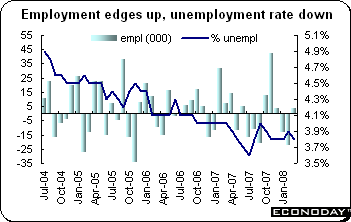 March unemployment rate edged down to 3.8 percent from 3.9 percent in the previous month. Employment was up 40,000 on the month but down 150,000 on the year. The number of unemployment persons declined 130,000 from the previous year. The job-to-applicant ratio, a measure of vacancies, showed that the number of positions available for each applicant slid to 0.95, the lowest in almost three years. New job offers, a leading indicator for the labor market, fell 21 percent from a year earlier. March unemployment rate edged down to 3.8 percent from 3.9 percent in the previous month. Employment was up 40,000 on the month but down 150,000 on the year. The number of unemployment persons declined 130,000 from the previous year. The job-to-applicant ratio, a measure of vacancies, showed that the number of positions available for each applicant slid to 0.95, the lowest in almost three years. New job offers, a leading indicator for the labor market, fell 21 percent from a year earlier.
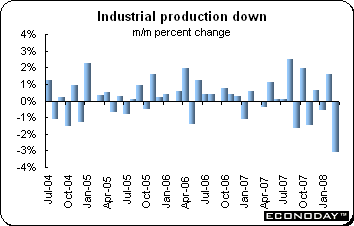 March industrial production sank 3.1 percent and was down 0.4 percent when compared with last year and continuing its zigzag pattern. Industrial production was up 1.6 percent in February. Moderate activity in manufacturing is needed in order to maintain employment growth and maintain the drip feed of income to the household sector. The industries that declined were transport equipment, general machinery and fabricated metals. Commodities that declined included large passenger cars and electronics and electronic toys. Shipment also declined in March, dropping 3.9 percent. March industrial production sank 3.1 percent and was down 0.4 percent when compared with last year and continuing its zigzag pattern. Industrial production was up 1.6 percent in February. Moderate activity in manufacturing is needed in order to maintain employment growth and maintain the drip feed of income to the household sector. The industries that declined were transport equipment, general machinery and fabricated metals. Commodities that declined included large passenger cars and electronics and electronic toys. Shipment also declined in March, dropping 3.9 percent.
 March retail sales were up a more than expected 0.5 percent and were up 5.1 percent when compared with the same month a year ago. Sales have been battered in the first quarter by slumping consumer confidence brought on by high gasoline prices and high interest rates. All components with the exception of food retailing and household goods retailing — both up 1.7 percent — declined. Department store sales dropped 0.7 percent while clothing & soft goods sank by 2 percent. Hospitality & services dropped 1.2 percent. Real retail sales, excluding inflation, posted a loss of 0.1 percent in the first quarter of 2008. March retail sales were up a more than expected 0.5 percent and were up 5.1 percent when compared with the same month a year ago. Sales have been battered in the first quarter by slumping consumer confidence brought on by high gasoline prices and high interest rates. All components with the exception of food retailing and household goods retailing — both up 1.7 percent — declined. Department store sales dropped 0.7 percent while clothing & soft goods sank by 2 percent. Hospitality & services dropped 1.2 percent. Real retail sales, excluding inflation, posted a loss of 0.1 percent in the first quarter of 2008.
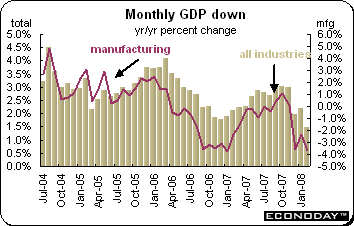 February monthly gross domestic product was down 0.2 percent but up 1.5 percent when compared with the same month a year ago. The monthly decline was split between the goods producing sector and services and reflected sharp drops in a number of output categories. Within the goods producing sector, there were especially steep monthly cutbacks in manufacturing (down 0.7 percent), mining & oil & gas extraction down 0.6 percent) and agriculture, forestry, fishing and hunting (down 0.5 percent). The only area to show an increase was construction (0.2 percent) although the shrinkage in utilities output (down 0.1 percent) was only minor. The energy sector contracted 0.9 percent. Within services the performances were more mixed with wholesale trade (down 1.4 percent) leading the way down, helped by retail trade (down 0.6 percent) and transport & warehousing (down 0.5 percent). But accommodation & food services were up 0.6 percent and arts, entertainment & recreation gained 0.4 percent. February monthly gross domestic product was down 0.2 percent but up 1.5 percent when compared with the same month a year ago. The monthly decline was split between the goods producing sector and services and reflected sharp drops in a number of output categories. Within the goods producing sector, there were especially steep monthly cutbacks in manufacturing (down 0.7 percent), mining & oil & gas extraction down 0.6 percent) and agriculture, forestry, fishing and hunting (down 0.5 percent). The only area to show an increase was construction (0.2 percent) although the shrinkage in utilities output (down 0.1 percent) was only minor. The energy sector contracted 0.9 percent. Within services the performances were more mixed with wholesale trade (down 1.4 percent) leading the way down, helped by retail trade (down 0.6 percent) and transport & warehousing (down 0.5 percent). But accommodation & food services were up 0.6 percent and arts, entertainment & recreation gained 0.4 percent.
March industrial product price index soared 1.7 percent but was down 0.3 percent when compared with the same month last year. Excluding exchange rate effects the IPPI would have gained 1.6 percent for annual growth of 3.7 percent. Almost inevitably, leading the monthly charge was petroleum & coal products which were up 8.0 percent, but there was also a steep increase in the cost of primary metals of 5.9 percent. Excluding the former category, the IPPI was  up 0.8 percent but was down 3.1 percent on the year. Miscellaneous manufactures (1.1 percent) and chemicals & chemical products (1.0 percent) and pulp & paper (1.0 percent) were the other main gainers. up 0.8 percent but was down 3.1 percent on the year. Miscellaneous manufactures (1.1 percent) and chemicals & chemical products (1.0 percent) and pulp & paper (1.0 percent) were the other main gainers.
March raw materials price index surged 6.6 percent — the strongest gain since September 1990 (7.9 percent). As a consequence, the index jumped 20.4 percent when compared with last year. The monthly leap was dominated by mineral fuels (11.5 percent) and, to a lesser extent, non-ferrous metals (4.8 percent). Excluding mineral fuels, the RMPI was up only 1.1 percent and was down 0.1 percent on the year. Among the other major sectors, there were sizeable increases in ferrous metals (0.9 percent) and non-metallic minerals (0.6 percent). The largest decline was in vegetables (3.2 percent).
News last week was dominated by the FOMC meeting. After the Fed cut its key fed funds target rate, it intimated in its post-meeting statement that it would pause before it took any further action on its interest rate policy. The decision was not unanimous. The Bank of Japan also met and kept its key interest rate at 0.5 percent. It also issued its semi-annual outlook in which they lowered their growth estimates for the economy. U.S. economic data surprised on the upside while data elsewhere were disappointing. In Japan industrial production was down while in Europe, retail sales and the PMI indexes declined.
The Reserve Bank of Australia, Bank of England the European Central Bank meet this week. Interest rates are expected to remain on hold at 7.25 percent, 5 percent and 4 percent respectively. All three banks have inflation targets and economies that are suffering from above target price increases.
| The following indicators will be released this week... |
| Europe |
|
|
| May 12 |
Italy |
Industrial Production (March) |
|
UK |
Merchandise Trade March) |
| May 13 |
UK |
Consumer Price Index (April) |
| May 14 |
EMU |
Industrial Production (March) |
|
UK |
Labor Market Report (April) |
| May 15 |
EMU |
Harmonized Index of Consumer Prices (April) |
|
|
Gross Domestic Product (Q1.08 preliminary) |
|
Germany |
Gross Domestic Product (Q1.08 preliminary) |
|
France |
Gross Domestic Product (Q1.08 preliminary) |
| May 16 |
France |
Merchandise Trade (March) |
|
Italy |
Merchandise Trade (March) |
|
|
|
| Asia/Pacific |
|
|
| May 14 |
Japan |
Corporate Goods Price Index (April) |
| May 16 |
Japan |
Gross Domestic Product (Q1.08 preliminary) |
|
|
|
| Americas |
|
|
| May 15 |
Canada |
Manufacturing shipments (March) |
Anne D Picker is the author of International Economic Indicators and Central Banks.
|

![[Econoday]](images/econoday_logo_slim.gif)
![[Econoday]](images/logo.gif)

 index was last unchanged on the day on June 8, 2007. It was the 14th time since 1984 that the index closed unchanged.
index was last unchanged on the day on June 8, 2007. It was the 14th time since 1984 that the index closed unchanged.  Most Asian/Pacific stock indexes were up last week. The exceptions were the Malaysian KLSE Composite and the Philippines PSEi, down 1.3 percent and 2 percent respectively. It was a relatively with little movement in a week that was strewn with holidays. And with most markets closed on Thursday, stocks caught up on Friday. Asian markets rallied on Wall Street's optimism, triggered by expectations that the U.S. economy will take a turn for the better. The major averages across the Asia/Pacific region closed Friday's session significantly higher, while the Chinese market remained closed for a second day.
Most Asian/Pacific stock indexes were up last week. The exceptions were the Malaysian KLSE Composite and the Philippines PSEi, down 1.3 percent and 2 percent respectively. It was a relatively with little movement in a week that was strewn with holidays. And with most markets closed on Thursday, stocks caught up on Friday. Asian markets rallied on Wall Street's optimism, triggered by expectations that the U.S. economy will take a turn for the better. The major averages across the Asia/Pacific region closed Friday's session significantly higher, while the Chinese market remained closed for a second day.  After the meeting’s conclusion the Bank of Japan released its semiannual Outlook. The Outlook for Economic Activity and Prices sets the parameters for policy over the next six to twelve months. As expected, the BoJ cut its economic growth forecast and predicted inflation would accelerate. However the report omitted a reference to raising interest rates for the first time in two years. The Bank estimated that the economy would grow 1.5 percent in the fiscal year ending March 31, less than an October estimate of 2.1 percent. The report said that the outlook for economic activity and prices is uncertain and, therefore, it is not appropriate to predetermine the direction of future monetary policy. Bank governor Masaaki Shirakawa said “that until the last report, our policy was aimed at adjusting interest-rate levels. This time, given that the economy is underperforming compared with expectations and risks are rising, our stance can be described as flexible. This is the best word to explain our policy stance.”
After the meeting’s conclusion the Bank of Japan released its semiannual Outlook. The Outlook for Economic Activity and Prices sets the parameters for policy over the next six to twelve months. As expected, the BoJ cut its economic growth forecast and predicted inflation would accelerate. However the report omitted a reference to raising interest rates for the first time in two years. The Bank estimated that the economy would grow 1.5 percent in the fiscal year ending March 31, less than an October estimate of 2.1 percent. The report said that the outlook for economic activity and prices is uncertain and, therefore, it is not appropriate to predetermine the direction of future monetary policy. Bank governor Masaaki Shirakawa said “that until the last report, our policy was aimed at adjusting interest-rate levels. This time, given that the economy is underperforming compared with expectations and risks are rising, our stance can be described as flexible. This is the best word to explain our policy stance.”  The U.S. dollar improved last week as a confluence of events conspired to give the currency a boost. Only two weeks after reaching an all time low against the euro, the currency has recovered sharply, triggering speculation that its long decline might be coming to an end. This week’s signal from the Fed that it would be pausing in its interest rate cutting cycle was the primary driving force behind the dollar’s rebound. However, improving equity markets and economic data also played a role. The dollar has declined along with interest rates since last summer as the Fed cut its policy interest rate by 3.25 percentage points to 2 percent. As the impact of the subprime mess spread, other major economies also felt the strain with the Banks of England and Canada cutting their policy rates as well — but not as drastically as the Fed. On the week, the dollar gained on all major currencies.
The U.S. dollar improved last week as a confluence of events conspired to give the currency a boost. Only two weeks after reaching an all time low against the euro, the currency has recovered sharply, triggering speculation that its long decline might be coming to an end. This week’s signal from the Fed that it would be pausing in its interest rate cutting cycle was the primary driving force behind the dollar’s rebound. However, improving equity markets and economic data also played a role. The dollar has declined along with interest rates since last summer as the Fed cut its policy interest rate by 3.25 percentage points to 2 percent. As the impact of the subprime mess spread, other major economies also felt the strain with the Banks of England and Canada cutting their policy rates as well — but not as drastically as the Fed. On the week, the dollar gained on all major currencies.  April flash
April flash  March
March  April
April  April
April 
 March
March  March
March  March
March  March
March  March
March  March
March  March
March  March
March  February monthly
February monthly  up 0.8 percent but was down 3.1 percent on the year. Miscellaneous manufactures (1.1 percent) and chemicals & chemical products (1.0 percent) and pulp & paper (1.0 percent) were the other main gainers.
up 0.8 percent but was down 3.1 percent on the year. Miscellaneous manufactures (1.1 percent) and chemicals & chemical products (1.0 percent) and pulp & paper (1.0 percent) were the other main gainers.